headlamp CADILLAC ESCALADE ESV 2009 Owners Manual
[x] Cancel search | Manufacturer: CADILLAC, Model Year: 2009, Model line: ESCALADE ESV, Model: CADILLAC ESCALADE ESV 2009Pages: 602, PDF Size: 5.18 MB
Page 2 of 602
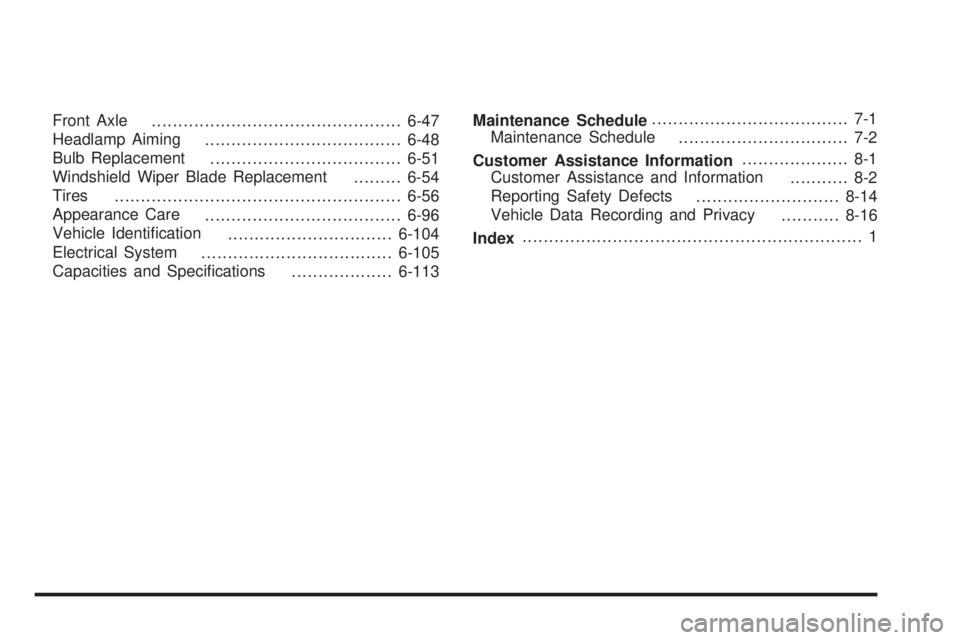
Front Axle
............................................... 6-47
Headlamp Aiming
..................................... 6-48
Bulb Replacement
.................................... 6-51
Windshield Wiper Blade Replacement
......... 6-54
Tires
...................................................... 6-56
Appearance Care
..................................... 6-96
Vehicle Identi�cation
............................... 6-104
Electrical System
.................................... 6-105
Capacities and Speci�cations
................... 6-113 Maintenance Schedule ..................................... 7-1
Maintenance Schedule
................................ 7-2
Customer Assistance Information .................... 8-1
Customer Assistance and Information
........... 8-2
Reporting Safety Defects
........................... 8-14
Vehicle Data Recording and Privacy
........... 8-16
Index ................................................................ 1
Page 5 of 602
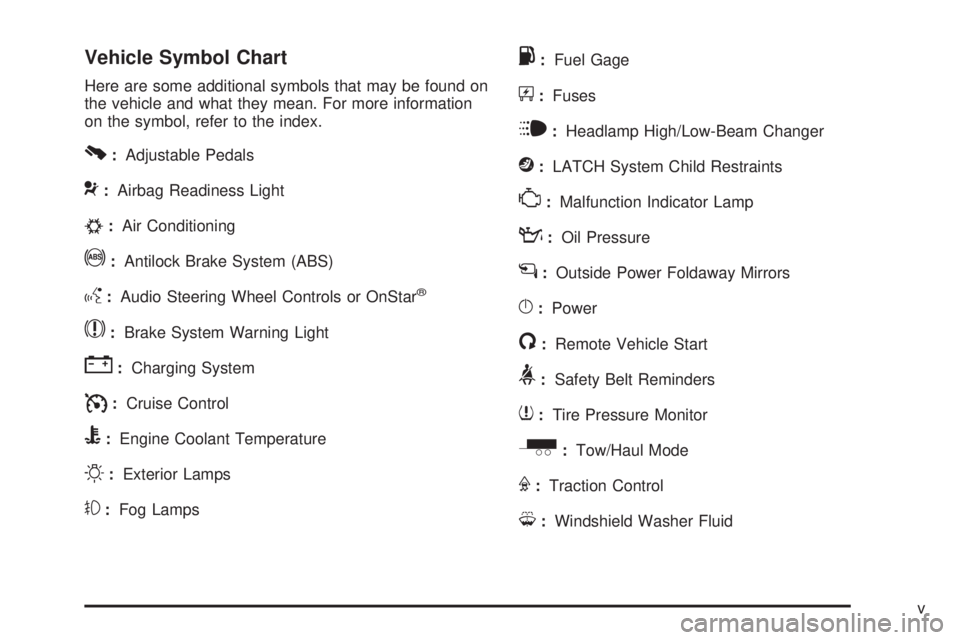
Vehicle Symbol Chart Here are some additional symbols that may be found on
the vehicle and what they mean. For more information
on the symbol, refer to the index.
0 : Adjustable Pedals
9 : Airbag Readiness Light
# : Air Conditioning
! : Antilock Brake System (ABS)
g : Audio Steering Wheel Controls or OnStar ®
$ : Brake System Warning Light
" : Charging System
I : Cruise Control
B : Engine Coolant Temperature
O : Exterior Lamps
# : Fog Lamps . : Fuel Gage
+ : Fuses
i : Headlamp High/Low-Beam Changer
j : LATCH System Child Restraints
* : Malfunction Indicator Lamp
: : Oil Pressure
g : Outside Power Foldaway Mirrors
} : Power
/ : Remote Vehicle Start
> : Safety Belt Reminders
7 : Tire Pressure Monitor
_ : Tow/Haul Mode
F : Traction Control
M : Windshield Washer Fluid
v
Page 123 of 602

Theft-Deterrent Systems Vehicle theft is big business, especially in some cities.
This vehicle has theft-deterrent features, however,
they do not make it impossible to steal.
Content Theft-Deterrent Your vehicle has a content theft-deterrent alarm system.
This is the security light.
To arm the theft-deterrent system:
1. Open the door.
2. Lock the door with the Remote Keyless Entry (RKE)
transmitter or the power door lock switch. The
security light will come on to inform the driver the
system is arming. If a door is open when the doors
are locked, the security light will �ash.
If the delayed locking feature is turned on, the
theft-deterrent system will not start the arming
process until the last door is closed and the delay
timer has expired. See Delayed Locking on
page 2-10 . 3. Close all doors. The security light should go off
after about 30 seconds. The alarm is not armed
until the security light goes off.
If a locked door is opened without using the RKE
transmitter, a ten second pre-alarm will occur. The
horn will chirp and the lights will �ash. If the key is not
placed in the ignition and turned to START or the door is
not unlocked by pressing the unlock button on the RKE
transmitter during the ten second pre-alarm, the alarm will
go off. Your vehicle’s headlamps will �ash and the horn
will sound for about 30 seconds, then will turn off to save
the battery power.
The theft-deterrent system will not activate if the doors
are locked with the vehicle’s key or the manual door lock.
It activates only if you use the power door lock switch with
the door open or the RKE transmitter. You should also
remember that you can start your vehicle with the correct
ignition key if the alarm has been set off.
To avoid setting off the alarm by accident:
If you do not want to activate the theft-deterrent
system, the vehicle should be locked with the
door key after the doors are closed.
Always unlock the doors with the RKE transmitter.
Unlocking a door any other way will set off the
alarm if it is armed.
If you set off the alarm by accident, press unlock on the
RKE transmitter or place the key in the ignition and turn it
to START to turn off the alarm. The alarm will not stop if
you try to unlock a door any other way.
2-21
Page 124 of 602
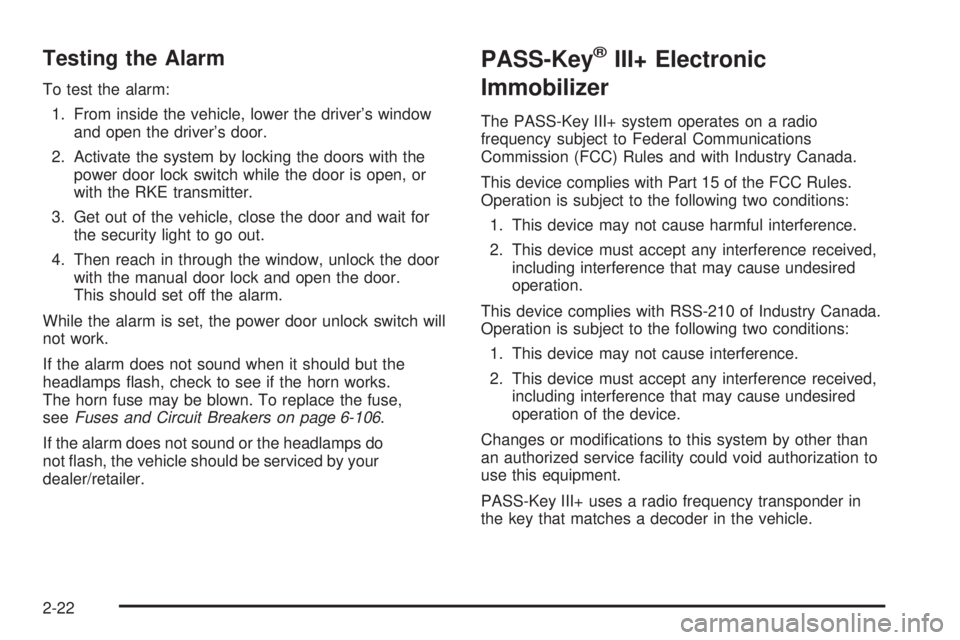
Testing the Alarm To test the alarm:
1. From inside the vehicle, lower the driver’s window
and open the driver’s door.
2. Activate the system by locking the doors with the
power door lock switch while the door is open, or
with the RKE transmitter.
3. Get out of the vehicle, close the door and wait for
the security light to go out.
4. Then reach in through the window, unlock the door
with the manual door lock and open the door.
This should set off the alarm.
While the alarm is set, the power door unlock switch will
not work.
If the alarm does not sound when it should but the
headlamps �ash, check to see if the horn works.
The horn fuse may be blown. To replace the fuse,
see Fuses and Circuit Breakers on page 6-106 .
If the alarm does not sound or the headlamps do
not �ash, the vehicle should be serviced by your
dealer/retailer. PASS-Key ®
III+ Electronic
Immobilizer The PASS-Key III+ system operates on a radio
frequency subject to Federal Communications
Commission (FCC) Rules and with Industry Canada.
This device complies with Part 15 of the FCC Rules.
Operation is subject to the following two conditions:
1. This device may not cause harmful interference.
2. This device must accept any interference received,
including interference that may cause undesired
operation.
This device complies with RSS-210 of Industry Canada.
Operation is subject to the following two conditions:
1. This device may not cause interference.
2. This device must accept any interference received,
including interference that may cause undesired
operation of the device.
Changes or modi�cations to this system by other than
an authorized service facility could void authorization to
use this equipment.
PASS-Key III+ uses a radio frequency transponder in
the key that matches a decoder in the vehicle.
2-22
Page 142 of 602

Mirrors Manual Rearview Mirror Hold the inside rearview mirror in the center to move it for
a clearer view behind your vehicle. Adjust the mirror to
avoid glare from the headlamps behind you. Push the tab
forward for daytime use and pull it for nighttime use.
Automatic Dimming Rearview Mirror This vehicle may have an automatic dimming inside
rearview mirror with OnStar ®
. It may also have
Intellibeam ®
. For more information on Intellibeam™, see
“Intellibeam™ Intelligent High-Beam Headlamp Control
System” under Exterior Lamps on page 3-16 . For more
information on OnStar ®
, see OnStar ®
System on
page 2-52 .
Automatic Dimming Mirror Operation Automatic dimming reduces the glare of lights from
behind the vehicle. The dimming feature comes on and
the indicator light illuminates each time the vehicle is
started.
O (On/Off): Press to turn the dimming feature on
or off. Cleaning the Mirror Do not spray glass cleaner directly on the mirror. Use a
soft towel dampened with water.
Outside Power Foldaway Mirrors Controls for the outside
power foldaway mirrors are
located on the driver door
armrest.
Mirror Adjustment 1. Press (C) to fold the mirrors out to the driving
position.
2. Press (D) to fold the mirrors in to the folded
position.
2-40
Page 143 of 602
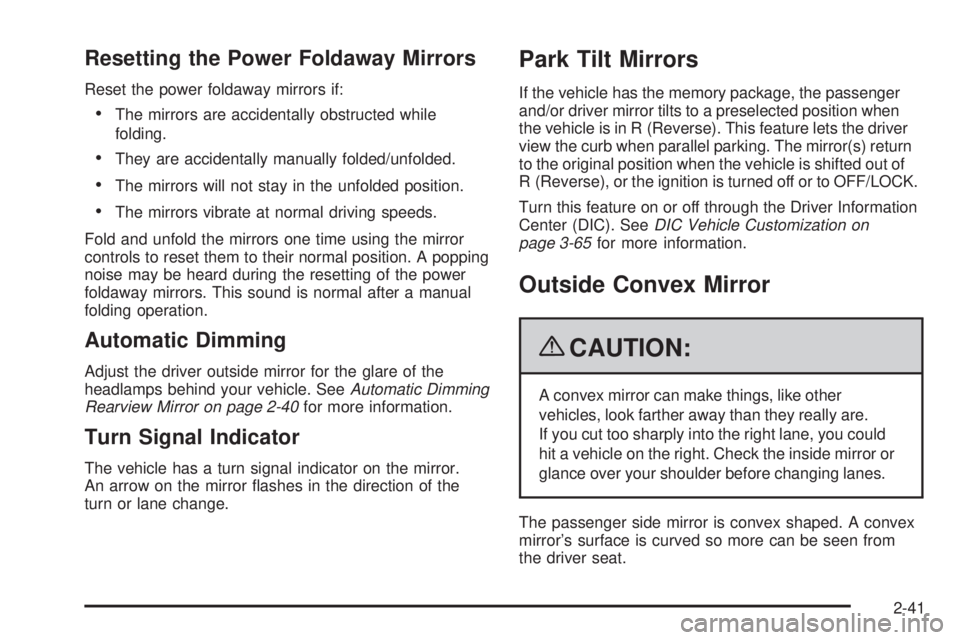
Resetting the Power Foldaway Mirrors Reset the power foldaway mirrors if:
The mirrors are accidentally obstructed while
folding.
They are accidentally manually folded/unfolded.
The mirrors will not stay in the unfolded position.
The mirrors vibrate at normal driving speeds.
Fold and unfold the mirrors one time using the mirror
controls to reset them to their normal position. A popping
noise may be heard during the resetting of the power
foldaway mirrors. This sound is normal after a manual
folding operation.
Automatic Dimming Adjust the driver outside mirror for the glare of the
headlamps behind your vehicle. See Automatic Dimming
Rearview Mirror on page 2-40 for more information.
Turn Signal Indicator The vehicle has a turn signal indicator on the mirror.
An arrow on the mirror �ashes in the direction of the
turn or lane change. Park Tilt Mirrors If the vehicle has the memory package, the passenger
and/or driver mirror tilts to a preselected position when
the vehicle is in R (Reverse). This feature lets the driver
view the curb when parallel parking. The mirror(s) return
to the original position when the vehicle is shifted out of
R (Reverse), or the ignition is turned off or to OFF/LOCK.
Turn this feature on or off through the Driver Information
Center (DIC). See DIC Vehicle Customization on
page 3-65 for more information.
Outside Convex Mirror
{ CAUTION: A convex mirror can make things, like other
vehicles, look farther away than they really are.
If you cut too sharply into the right lane, you could
hit a vehicle on the right. Check the inside mirror or
glance over your shoulder before changing lanes.
The passenger side mirror is convex shaped. A convex
mirror’s surface is curved so more can be seen from
the driver seat.
2-41
Page 169 of 602
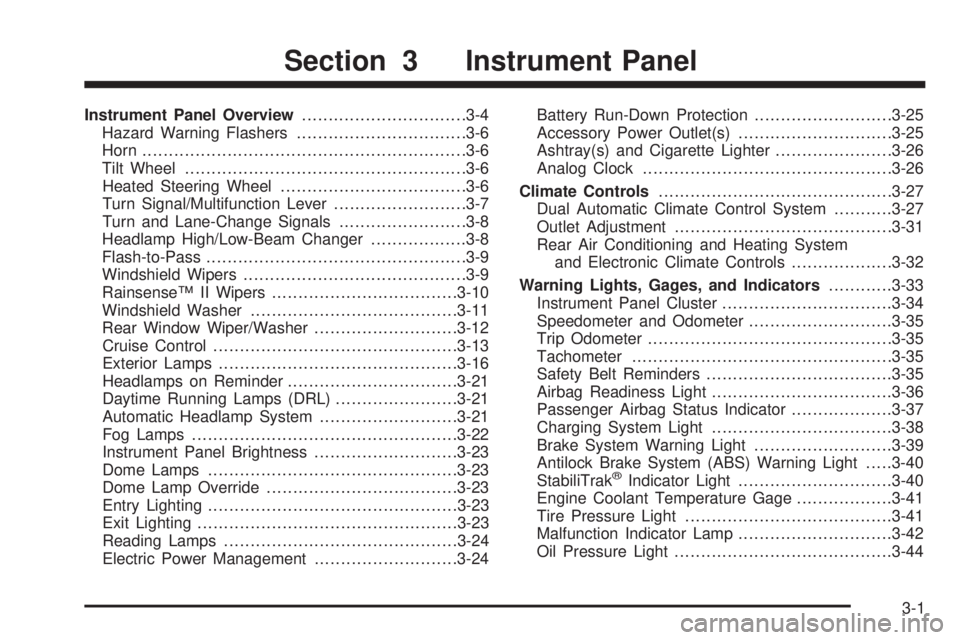
Instrument Panel Overview .............................. .3-4
Hazard Warning Flashers ............................... .3-6
Horn ............................................................ .3-6
Tilt Wheel .................................................... .3-6
Heated Steering Wheel .................................. .3-6
Turn Signal/Multifunction Lever ........................ .3-7
Turn and Lane-Change Signals ....................... .3-8
Headlamp High/Low-Beam Changer ................. .3-8
Flash-to-Pass ................................................ .3-9
Windshield Wipers ......................................... .3-9
Rainsense™ II Wipers .................................. .3-10
Windshield Washer ...................................... .3-11
Rear Window Wiper/Washer .......................... .3-12
Cruise Control ............................................. .3-13
Exterior Lamps ............................................ .3-16
Headlamps on Reminder ............................... .3-21
Daytime Running Lamps (DRL) ...................... .3-21
Automatic Headlamp System ......................... .3-21
Fog Lamps ................................................. .3-22
Instrument Panel Brightness .......................... .3-23
Dome Lamps .............................................. .3-23
Dome Lamp Override ................................... .3-23
Entry Lighting .............................................. .3-23
Exit Lighting ................................................ .3-23
Reading Lamps ........................................... .3-24
Electric Power Management .......................... .3-24 Battery Run-Down Protection ......................... .3-25
Accessory Power Outlet(s) ............................ .3-25
Ashtray(s) and Cigarette Lighter ..................... .3-26
Analog Clock .............................................. .3-26
Climate Controls ........................................... .3-27
Dual Automatic Climate Control System .......... .3-27
Outlet Adjustment ........................................ .3-31
Rear Air Conditioning and Heating System
and Electronic Climate Controls .................. .3-32
Warning Lights, Gages, and Indicators ........... .3-33
Instrument
Panel Cluster ............................... .3-34
Speedometer and Odometer .......................... .3-35
Trip Odometer ............................................. .3-35
Tachometer ................................................ .3-35
Safety Belt Reminders .................................. .3-35
Airbag Readiness Light ................................. .3-36
Passenger Airbag Status Indicator .................. .3-37
Charging System Light ................................. .3-38
Brake System Warning Light ......................... .3-39
Antilock Brake System (ABS) Warning Light .... .3-40
StabiliTrak ®
Indicator Light ............................ .3-40
Engine Coolant Temperature Gage ................. .3-41
Tire Pressure Light ...................................... .3-41
Malfunction Indicator Lamp ............................ .3-42
Oil Pressure Light ........................................ .3-44Section 3 Instrument Panel
3-1
Page 175 of 602
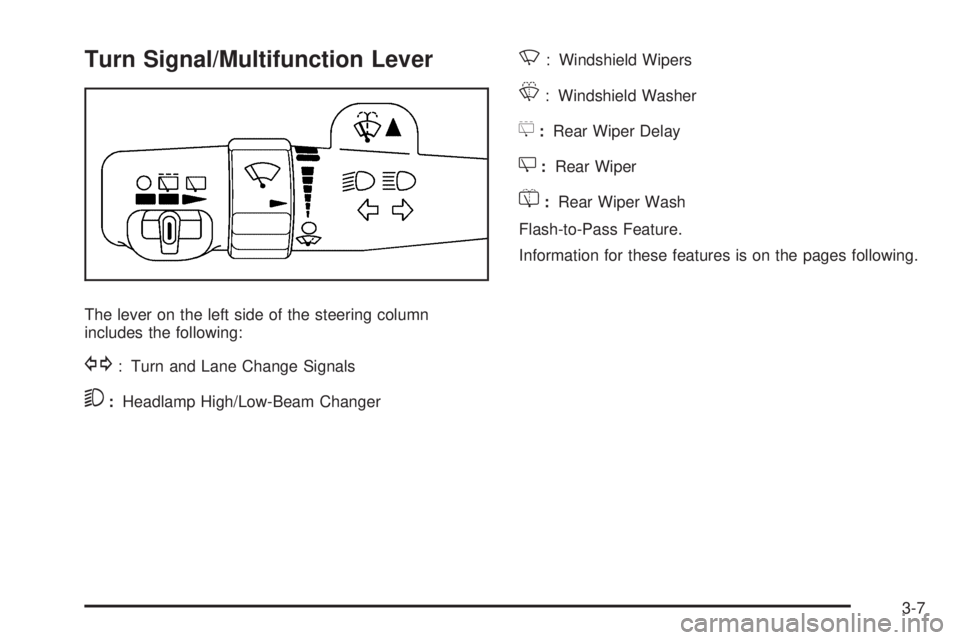
Turn Signal/Multifunction Lever
The lever on the left side of the steering column
includes the following:
G : Turn and Lane Change Signals
5 : Headlamp High/Low-Beam Changer N : Windshield Wipers
L : Windshield Washer
5 : Rear Wiper Delay
Z : Rear Wiper
= : Rear Wiper Wash
Flash-to-Pass Feature.
Information for these features is on the pages following.
3-7
Page 176 of 602
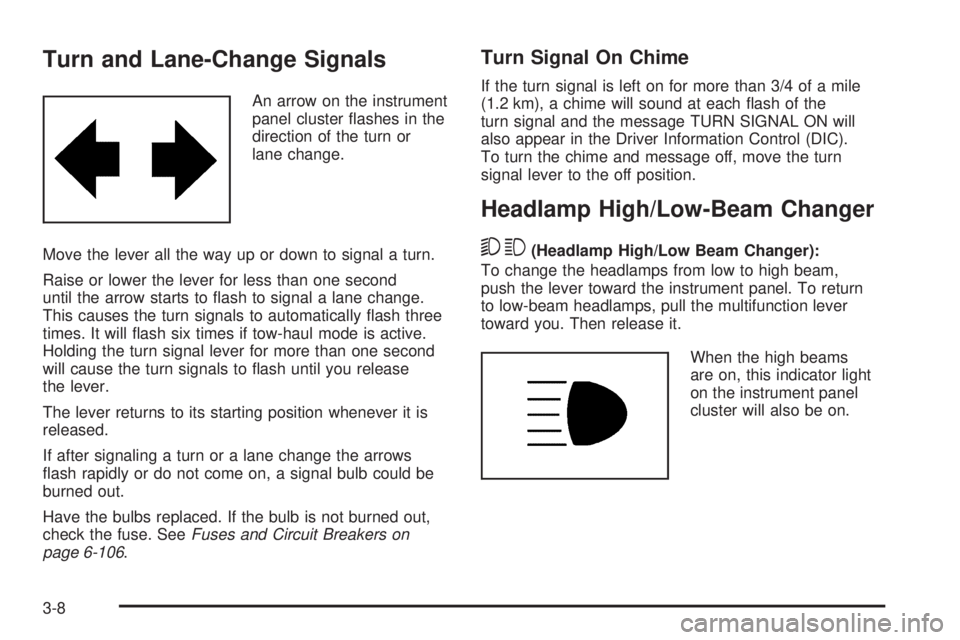
Turn and Lane-Change Signals An arrow on the instrument
panel cluster �ashes in the
direction of the turn or
lane change.
Move the lever all the way up or down to signal a turn.
Raise or lower the lever for less than one second
until the arrow starts to �ash to signal a lane change.
This causes the turn signals to automatically �ash three
times. It will �ash six times if tow-haul mode is active.
Holding the turn signal lever for more than one second
will cause the turn signals to �ash until you release
the lever.
The lever returns to its starting position whenever it is
released.
If after signaling a turn or a lane change the arrows
�ash rapidly or do not come on, a signal bulb could be
burned out.
Have the bulbs replaced. If the bulb is not burned out,
check the fuse. See Fuses and Circuit Breakers on
page 6-106 . Turn Signal On Chime If the turn signal is left on for more than 3/4 of a mile
(1.2 km), a chime will sound at each �ash of the
turn signal and the message TURN SIGNAL ON will
also appear in the Driver Information Control (DIC).
To turn the chime and message off, move the turn
signal lever to the off position.
Headlamp High/Low-Beam Changer
53 (Headlamp High/Low Beam Changer):
To change the headlamps from low to high beam,
push the lever toward the instrument panel. To return
to low-beam headlamps, pull the multifunction lever
toward you. Then release it.
When the high beams
are on, this indicator light
on the instrument panel
cluster will also be on.
3-8
Page 177 of 602
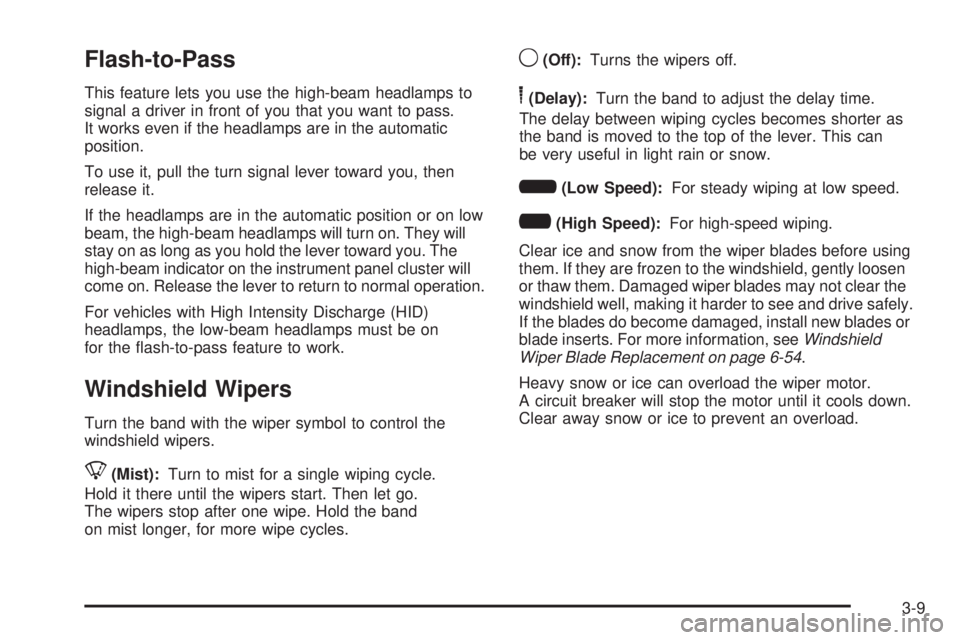
Flash-to-Pass This feature lets you use the high-beam headlamps to
signal a driver in front of you that you want to pass.
It works even if the headlamps are in the automatic
position.
To use it, pull the turn signal lever toward you, then
release it.
If the headlamps are in the automatic position or on low
beam, the high-beam headlamps will turn on. They will
stay on as long as you hold the lever toward you. The
high-beam indicator on the instrument panel cluster will
come on. Release the lever to return to normal operation.
For vehicles with High Intensity Discharge (HID)
headlamps, the low-beam headlamps must be on
for the �ash-to-pass feature to work.
Windshield Wipers Turn the band with the wiper symbol to control the
windshield wipers.
8 (Mist): Turn to mist for a single wiping cycle.
Hold it there until the wipers start. Then let go.
The wipers stop after one wipe. Hold the band
on mist longer, for more wipe cycles. 9 (Off): Turns the wipers off.
6 (Delay): Turn the band to adjust the delay time.
The delay between wiping cycles becomes shorter as
the band is moved to the top of the lever. This can
be very useful in light rain or snow.
6 (Low Speed): For steady wiping at low speed.
? (High Speed): For high-speed wiping.
Clear ice and snow from the wiper blades before using
them. If they are frozen to the windshield, gently loosen
or thaw them. Damaged wiper blades may not clear the
windshield well, making it harder to see and drive safely.
If the blades do become damaged, install new blades or
blade inserts. For more information, see Windshield
Wiper Blade Replacement on page 6-54 .
Heavy snow or ice can overload the wiper motor.
A circuit breaker will stop the motor until it cools down.
Clear away snow or ice to prevent an overload.
3-9